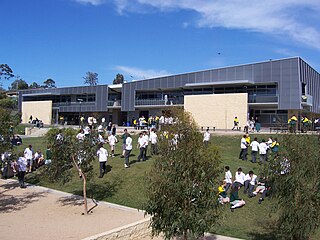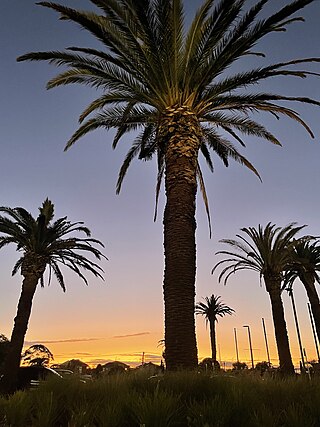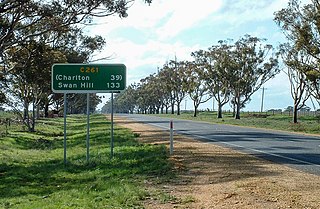
Mount Waverley Secondary College is a public secondary school located in the Melbourne suburb of Mount Waverley. The school consists of roughly 1900 students and is one of the largest in the state. The school consists of two campuses both situated on Stephensons Road in Mount Waverley. The Junior Campus holds years 7 and 8, with year levels 9 to 12 at the Senior Campus. The campuses are a short walking distance apart.

Murrumbeena is a suburb in Melbourne, Victoria, Australia, 13 km south-east of Melbourne's Central Business District, located within the City of Glen Eira local government area. Murrumbeena recorded a population of 9,996 at the 2021 census.

Dimboola is a town in the Shire of Hindmarsh in the Wimmera region of western Victoria, Australia, 334 kilometres north-west of Melbourne.

Warracknabeal is a town in the Australian state of Victoria, located in the Victorian wheatbelt. Situated on the banks of the Yarriambiack Creek, 330 km northwest of Melbourne, it is the business and services centre of the northern Wimmera and southern Mallee districts, and hosts local government offices of the Shire of Yarriambiack. At the 2011 census, Warracknabeal district had a population of 2,745, of which 2,340 lived in the town.

The Borung Highway is a 138 kilometre rural highway in western Victoria running in a west–east direction from Dimboola in the west to Charlton in the east. The highway serves little more than connectivity between local communities, and is busiest between the towns of Donald and Charlton. The more notable features along the highway exist in the pastoral scenery, and the surprising appearance of lakes amongst the rolling hills. Buloke trees, are a regular feature along the eastern segment of the road.

Horsham is a regional city in the Wimmera region of western Victoria, Australia. Located on a bend in the Wimmera River, Horsham is approximately 300 kilometres (190 mi) northwest of the state capital Melbourne. As of the 2021 census, Horsham had a population of 20,429. It is the most populous city in Wimmera, and the main administrative centre for the Rural City of Horsham local government area. It is the eleventh largest city in Victoria after Melbourne, Geelong, Ballarat, Bendigo, Wodonga, Mildura, Shepparton, Warrnambool, Traralgon, and Wangaratta.
Parkdale Secondary College is a public, co-educational secondary school located on Warren Road in the Melbourne suburb of Mordialloc, Victoria.
The Energy Breakthrough, previously known by its sponsorship name RACV Energy Breakthrough, is a joint initiative of the Country Education Project, the Shire of Central Goldfields and the Royal Automobile Club of Victoria (RACV).

Damascus College is Ballarat’s only Catholic co-educational secondary college. It was established in 1995 after three separate Catholic colleges, St Martin's in the Pines, Sacred Heart College and St Paul's College amalgamated. The college is located on a treed 20 hectare campus in Mount Clear, 7 km from Ballarat's central business district. Damascus College is a day school for secondary students in years 7 to 12.
Oberon High School is a secondary school located in Armstrong Creek, Geelong, Victoria, Australia. Established in 1963, in the Geelong suburb of Belmont, Oberon High is a single campus years 7–12 school, now situated in the suburb of Armstrong Creek. The current principal is Tim McMahon.
Ave Maria College is a Catholic secondary school for girls, established in 1963 by the Franciscan Missionaries of Mary (FMM). The college is located in Aberfeldie, a suburb of Melbourne, Australia.

Henty Highway is a rural highway in western Victoria, Australia. It is primarily a north-south route, consisting of a mix of dual-lane, single-carriageway country highway and four-lane arterial road within some of the larger towns along the route. It was named in honour of Edward Henty, a British colonist regarded as the first permanent European settler of the Port Phillip District, in the town eventually named Portland.
Pimpinio is a town in the Rural City of Horsham, Victoria, Australia. It is 15 km from the City of Horsham and 317 km from the Victorian capital city Melbourne. As of the 2021 Australian census, Pimpinio had a population of 191 people.
Princes Hill Secondary College is a coeducational state secondary school, located in Princes Hill, an inner suburb of Melbourne, Victoria, Australia. The school is 2 kilometres from the Melbourne City Centre.

Saint Ignatius College is an independent Catholic secondary day school for boys and girls, located in the rural hinterland of the Bellarine Peninsula near Geelong, Victoria, Australia. The school provides education from Year 7 to Year 12, conducted in the Jesuit tradition, and operates with oversight from the Roman Catholic Archdiocese of Melbourne. The college is part of the international network of Jesuit schools begun in Messina, Sicily in 1548.

Brim is a small town in the Wimmera region of Victoria, Australia. The town is located 359 kilometres (223 mi) north west of the state capital, Melbourne on the Henty Highway. It is on the banks of the Yarriambiack Creek. It is in the Shire of Yarriambiack local government area. At the 2016 census, Brim had a population of 171.
The Fraser Coast Technology Challenge is an annual youth and technology event held in Maryborough, Queensland, Australia. The Royal Automobile Club of Queensland has been a committed supporter of this event. The Fraser Coast Technology Challenge aims to help develop efficient, environmentally friendly, vehicles as forms of transport, as well as using emerging technologies in ways to help further students education. Schools from across Australia and New Zealand enter teams in the challenge. 2012 was the 10 year anniversary of the first running of the event.

Sheep Hills is a locality in the northern Wimmera region, north-west Victoria. It is 271 km north-west of Melbourne. The locality is situated on the railway line south-east of Warracknabeal, north of Minyip.
Aubrey is a locality west of Warracknabeal in Victoria.
The Prahran College of Advanced Education, formerly Prahran College of Technology, was a late-secondary and tertiary institution with a business school, a trade school, and a multi-disciplinary art school that dated back to the 1860s, populated by instructors and students who were among Australia’s significant artists, designers and performers.













